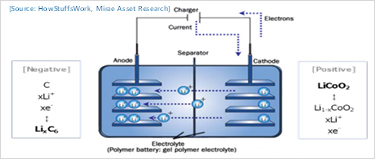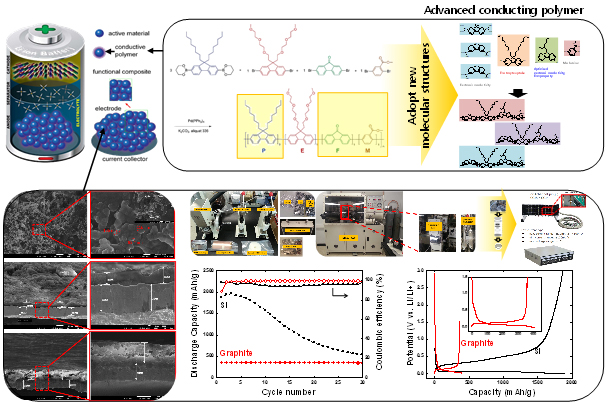■ Silicon nanoparticle-conducting polymer hybrid anode materials
for lithium ion battery ■□ Overview of Lithium Ion Battery (LIB)
A lithium-ion battery (sometimes Li-ion battery or LIB) is a member of a family of rechargeable battery types in which lithium ions move from the negative electrode to the positive electrode during discharge and back when charging. Li-ion batteries use an intercalated lithium compound as one electrode material, compared to the metallic lithium used in a non-rechargeable lithium battery. The electrolyte, which allows for ionic movement, and the two electrodes are the constituent components of a lithium-ion battery cell. 
Since the demand for safe Li-ion batteries exhibiting high power, large capacity, and high rate capability is ever increasing, research has been carried out worldwide to find new electrode materials to replace the currently used materials. □ Silicon nanoparticles as an anode materials in LIB
Si has been considered as one of the most attractive anode materials for Li-ion batteries because it has the highest gravimetric and volumetric capacity and is also abundant, cheap, and environmentally benign. However, it showed capacity fading due to mechanical failure of the active material caused by the large volume expansion/contraction during the discharge/ charge reactions. In order to overcome this problem, various approaches have been applied such as the use of active-inactive binary alloys and Si dispersion in active and/or inactive matrices.
□ Recent research interest in silicon nanoparticle (Si NP)-conducting polymer hybrid anode
materials for lithium ion battery
A traditional binder system is dual-component based, essentially with two components for two different functionalities. Polymer binders, such as polyvinylidene fluoride (PVDF), mechanically hold the active materials and additives together. Electronically conductive additives, such as acetylene black (AB), are necessary to ensure electrical conductivity of the entire electrode. Although such classic dual-component binder design is popular in the current Li-ion batteries, it does not work well for the high-capacity electrodes with large volume change. The dilemma of employing high-capacity battery materials (e.g. Si) and maintaining the electronic and mechanical integrity of electrodes demands novel designs of binder systems. Hence our group keep studying about functionalization of Si NP, synthesis of conducting binder and Si NP-conducting polymer hybrid anode materials to overcome aforementioned drawbacks in LIB system. |
 Quantum Electronic Materials Lab.
Quantum Electronic Materials Lab.